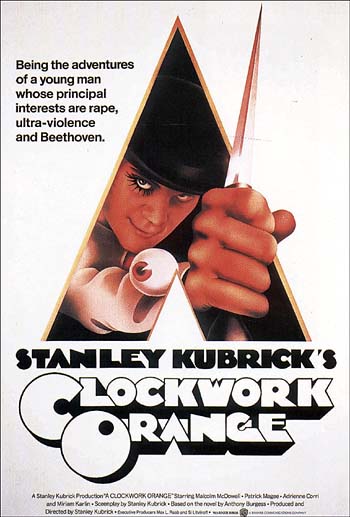
“Kubrick: and beyond the cinema frame”
An in-depth analysis of
2001: A SPACE ODYSSEY
Text copyright © by Rob Ager 2008
(last updates added 2015)
CHAPTER 11
KUBRICK’S WAR CRY

The topic in this chapter is the presence of elitist philosophy references in 2001, but before continuing, I first need to clarify a few things both for believers and non-believers of what are widely referred to as “conspiracy theories”. The most important thing to be aware of regarding this subject is what I call the “polarization effect”. Many issues in modern society are difficult to discuss rationally in the public domain because they have been divided into camps of extreme agreement and extreme disagreement with no room for middle ground opinions. Each side will have elements of truth in their argument, but will stubbornly deny that a single shred of truth exists at the opposite end of the debate. Instead they will resort to convenient name calling in attempt to discredit their opposition. Some examples of issues that often become polarized are:
Now I’m well aware that conspiracy ideas are sometimes poorly researched and sometimes promoted by people who have emotional problems or alternative agendas. At the same time anybody who thinks large scale conspiracies simply don’t happen at all is in a state of either plain ignorance or denial and hence are equally dysfunctional. History has been full of widely acknowledged conspiracies and the word "conspiracy" is basically a much more exotic word for plain old "corruption".
Extensive hammering of the catch phrase "conspiracy theory" in the media has misled many people into believing that conspiracies always lack evidence. However, criminal law itself ackowledges that this is not the case. In a court of law you can be charged with "conspiracy to commit murder" or "conspiracy to defraud" amongst other things, and when people are found guilty and sentenced for such crimes it is because a judge or jury has found there to be "proof" that "conspiracy" has occurred.
So in the same way that detectives, scientists, judges and juries allow themselves to explore a variety of abstract lines of investigation, it’s ok for you to explore conspiracy theories … because sometimes real corruption can be uncovered in the middle ground.In the context of this review such areas of study will give you greater insight into one of the most talented film makers of all time.
"The great nations have always acted like gangsters and the small ones like prostitutes." - Stanley Kubrick
As already demonstrated in my reviews of A Clockwork Orange, Eyes Wide Shut and The Shining, Stanley Kubrick undoubtedly had a conspiratorial view of society and he carefully expressed these views in his films. And we’ve already explored similar territory in this review with regards to the technological enslavement of man by corrupt computing corporations and in the idea that HAL may be representing or taking orders from human sources. There are many conspiracy orientated reviews of 2001 that claim the film is embedded with secretive religious symbols. Personally I haven’t found any of these reviews convincing, but as I said earlier sometimes the truth is in the middle ground. My main disagreement with the idea of 2001 being a promotion of ancient elitist and secret philosophies is that it is not consistent with Kubrick’s other work. His hidden narratives are often viciously critical of corrupt establishments and elitist ideologies. The most commonly perceived of these symbols in 2001 are the egyptian pyramid and sun worship symbols. For those of you not familiar with these symbols, the eye in a triangular capstone at the top of a pyramid represents the all seeing and light bringing eye of God. It is also said to represent the illuminated ones who have been initiated at the highest levels. The large base section of the pyramid represents the hierarchical structure of society or the masses who have not reached enlightenment.

This may sound like an airy fairy mystical religion, but it’s basically the same philosophical ideology that most elitist organisations have fostered for themselves across history – the belief that they as a group are intellectually or spiritually superior to the common man and therefore have both the divine right and the responsibility to be our rulers. Ok, so where does this stuff make its appearance in 2001? Well, the most blatant example that I’ve found is the space pods, which are basically large eyeballs. The slight elongation of the corneal window and additional design features make this metaphor difficult to notice unless it's pointed out.

There are many clues that not only the pod is an eyeball, but that it has the blazing illumination of the eye of God. Its bright head lights shine directly at the camera in several shots.


One of the production stills shows the pod with its lights giving off lens refractions in all directions, similar to the stargate explosion.


When it attacks Poole the pods arms stretch out toward us like the sunrays seen in esoteric religious art.

The pod is shown twice racing toward the camera in a way that mimics the explosion of enlightenment in the star gate. It also has “explosive bolt” warnings both on its interior and exterior, and the pod bay doors open and close like eyelids.

An in-genius piece of visual encoding is the four equally positioned circular indentations on the top of the pods. From certain angles the shadows play tricks so that they look exactly like moving eyeballs. The pod rotating before it kills Poole is the most clear shot of this. To bring these indentations to our attention Kubrick has turned one of the rear indentations inside out so that it protrudes – letting us know that the eyeball light trick is not an accident.


The colour filtered eye in the stargate also represents the pod and to emphasize this one of the more bizarre marketing posters shows the star child inside the cornea of a giant multicoloured eye. This is the enlightened and reborn Dave Bowman inside the space pod.



Some other eye or sun references include the circular blue and white logos on either side of the astronauts helmets (based upon the NASA insignia) ...
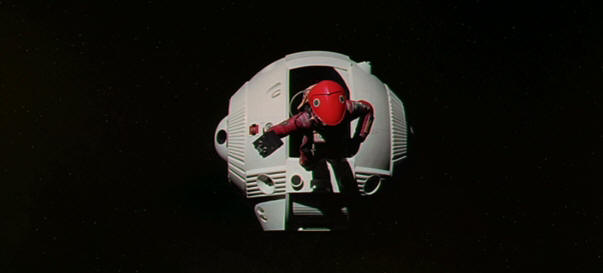
... and this production photo of a yellow suited astronaut stood inside the airlock staring at us. The bright bar patterns on the walls are emanating from him like sunrays. He is an enlightened being.

The following poster features colour alterations communicating the same theme with the octagonal door representing an elongated cornea.

An obscure observation that could just be accidental – it’s difficult to tell with Kubrick – is that in the first shot of Jupiter a small blue moon is seen on the left. It has a dark pattern that looks very remotely like an eye. Whether this is part of 2001’s symbolism I’m unsure, but according to the brief research I’ve done, none of Jupiter’s moons match up with this image.

Many cultures have traditionally symbolized the sun as a dot within the centre of a circle. This is very similar not just to the eye of HAL, but also to the famous Tycho moon crater. It is only spoken of in the film, but a quick online image search shows Tycho as a circular crater with a small mountain in its exact centre, which may or may not have been deliberate on Kubrick's part.


A frequently sited pyramid image in 2001 is the shot of the erect monolith pointed at the moon, which is shown as the apes huddle at the monolith base.
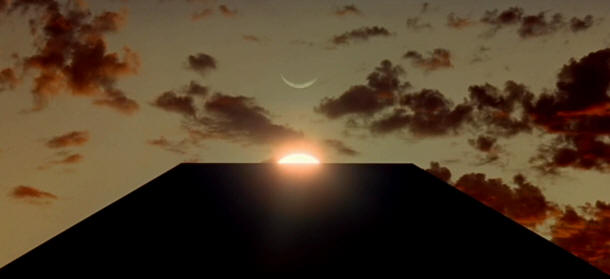
It’s easy to make the assumption that this pyramid structure is a low angle view of the monolith, but what is often not acknowledged is that if the film is a promotion of elitist symbolism then the sun should be blazing at the apex position? Instead we see a crescent moon at the apex with the sun emerging from the base. If anything, this is an anti-elitist message, showing the apex as a sleeping eye with enlightenment occurring below the ranks. Notice also that when the apes are admiring the monolith the sun hasn’t even risen yet.
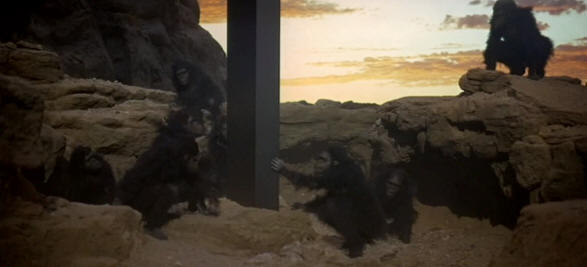
So how does the sun suddenly appear high enough in the sky to be almost directly above the monolith? My interpretation is that it didn’t. The black pyramid base that we see is not actually the monolith. It is a pyramid on the horizon of the landscape, hence the sun is rising after the apes are seen touching the monolith. The aptly named “Dawn of Man” is the enlightenment of the apes and their eventual emergence out of the controlled pyramid hierarchy.As a hint of this, the rising sun is seen in the opening shots emerging from mountains on the horizon. Four shots takes us from dawn to mid day. Notice that the same lanscsape view is featured in the first and second shot and then a second landscape is shown for shots three and four.




Given Kubricks career-long belief that corrupt and secretive alliances control world affairs (a view shared in many conspiracy theories) these anti-elitist symbols seem to be expressing his desire for the masses to free themselves from corrupt rule.So the “Dawn of Man” represents rebellion from lower down the hierarchy. The apes territory and resources have been taken from them by an intruding clan and when it dawns upon them what the monolith actually is they suddenly gain enlightenment. This leap of intelligence enables them to take back their territory. Notice that before the fight they are seen outside their cave with the sun peaking over a hill on the horizon again. They are planning and preparing their attack. They are the enlightened base of the pyramid and like the morning sun are about to rise and enlighten the landscape.

With their new found weapons they only need to kill one ape to secure victory. The smashing of the enemy leader’s skull with a bone is a direct parallel to Dave Bowman knocking out HALs higher brain functions with a screw driver. A symbol of these mutual weapons is shown on the exterior of the airlock door on the discovery (shown through the pod window). It features an engraved outline of what looks like a synthesis between a bone and a screwdriver.

The arms of the pod are then seen unscrewing the handles of the airlock like the unscrewing of HALs memory cells. A caption written beneath the handles says “manual operation only”, which also hints at the act of physically picking up a bone or screwdriver.

So essentially, the whole dawn of man sequence is a short and simplified version of the films later events. The rest of the film replays the ape story as a battle between technologically enslaved people and their corrupt controllers who are personified in the dual characters of HAL, Floyd and the Council. The “epidemic at the base” is essentially a mass recognition of the monoliths meaning by those lower down the social power structure. The pilots in the moon bus gain their understanding of the monolith from their computer screens and this occurs while Floyd and his colleagues are in the back of the vehicle puzzling over diagrams and photos. The same thing happens as Floyd sleeps during his space voyages. When he is asleep on the Pan Am ship with a widescreen tv in front of him, a black pen floats into shot in the upper right at a horizontal angle. It floats over the tv screen, gradually rotating into a vertical position.

White reflections pass over its surface, like with the monolith near Jupiter. And a deliberate continuity error is that the pen is moving in an arc instead of maintaining a straight path. As it’s about to match up horizontally with the black door in the background of the shot we cut to a wide reverse angle. Now the pen has stopped moving all together and has even stopped spinning. We next cut to a close up of the pen and suddenly it’s spinning again. It seems to have a life of its own.

The hostess approaches and grabs the pen just as it spins back into a horizontal position then places it vertically in Floyds pocket and turns off the tv. Perhaps she recognises the monolith / screen connection.
The content of the tv screen that Floyd was watching before he fell asleep is interesting. It shows a futuristic vehicle of some sort then a profile view of two characters talking. This is probably a re-inforcement of Floyd and HAL symbolically representing each other. HAL also watches a profile view of people talking (the lip reading of Poole and Bowman in the pod). So the hostess switching off the tv could be a representation of cutting HALs surveillance capabilities.


During Floyds trip to clavius another hostess is seen collecting dinner trays, which are shaped like horizontally positioned monoliths. Her awareness of the monolith meaning is communicated in two production stills. She is seen staring at the white monolith on the wall and she is seen staring at the camera acknowledging the other side of the cinema screen.


She walks in a rotating circle on her way to the cockpit and the music suddenly intensifies as she faces a set of illuminated white strips in the floor, which again represent the cells of HALs brain.

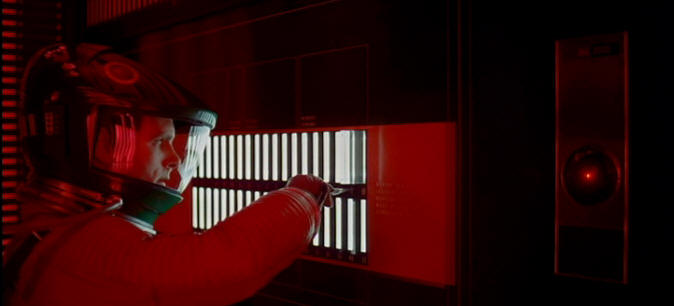
Another production photo emphasizes these cells by showing a set of them in the foreground. Like the cells of HALs brain they are in rows of two.

When she enters the cockpit she hands out the rectangular dinner trays to the pilots.


In the passenger area we find that Floyd is asleep once again. The hostess passes a tray to her colleague and the two of them smile and whisper to each other as they look over at Floyd.

The handing out of rectangular trays here obviously represents the enlightened hostess informing her co-workers of the monoliths true meaning. This is the “epidemic” in action. Notice also that the hostess, who is about to eat, is sat before a widescreen window watching three men practice Karate. Is this a preparation for conflict? One of the pilots then comes up to the passenger area with a grin on his face and chats to Floyd. The dinner tray begins floating away like a wandering monolith and the pilot points it out for Floyd to grab hold of again. Strangely, the pilot appears to be played by the same actor who plays the photographer in the council meeting. Only the pilot has an official credit in the production even though the photographer is the one speaking a line of dialogue.

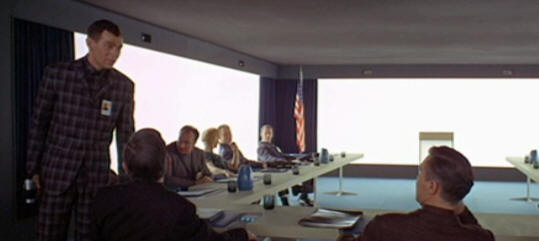
Just like the apes, who had their epidemic at the base of a monolith, the humans are now spreading their enlightenment. They are preparing to take back the Earth from those who have monopolised it. This is serious revolutionary messaging by Kubrick.

This hidden narrative of humans achieving enlightenment and then freeing themselves from corrupt leaderships explains many other features of 2001 that would otherwise seem obscure. For example, let’s examine the lunar excavation scene again. Remember the handheld shot of a single circular flood light passing behind the monolith? This shot cuts and we see what appears to be a reverse angle of Floyd continuing to circle the monolith. But, as we identified earlier in this review, Floyd is the one who has flipped positions, not the camera. His mirror image has emerged from the reverse side of the monolith, indicating that the excavation site is divided into a parallel reality.

A very curious aspect of this scene is that there are six astronauts who descend down the ramp, but including the pilots there were only five in the moon bus. So where does the extra astronaut come in? The parallel or reflected reality of the excavation offers an explanation. It is Floyd, Halvorsen and “Bill” who descend down the ramp. The three unidentified additional astronauts are their reflections in the dual reality of the excavation. Floyd and his two side-kicks are not aware of their own reflections because they have not yet realised that the monolith is a cinema screen upon which they are being projected for all to see. This may be why the handheld shot descending the ramp only shows three of the astronauts.
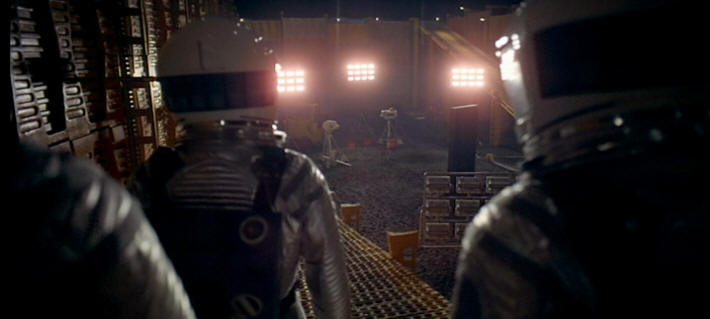
Kubrick is mocking the members of the council. Even the apes managed to figure out what the monolith is, but Floyd and his colleagues remain baffled until the moment of the group photo when the floodlight aligns with its own lens flare.
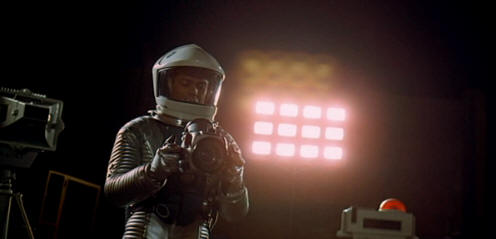
The mockery goes even further. Floyd struggles to make sense of anti-gravity toilet instructions that are written in a monolith rectangle, but when Bowman looks into the bathroom mirror, not only is he acknowledging his own reflection; he can also see a simple and easy to use toilet. The awkward toilet instructions are probably also emphasizing how irrelevant the surface narrative of the film is.


So in the excavation pit why do the astronauts panic at the realization that the monolith is a cinema screen? After all, the apes seemed to be comforted by it? The answer is very straight forward. Floyd and his colleagues represent the so-called “illuminated ones” at the top of the corruption hierarchy – the people who Kubrick and many “conspiracy theorists” believe are the mortal enemies of humanity.
This could also explain why the astronauts are cryptically dressed in white coats in one of the production stills of the excavation site.

In the council room Floyd even announced a need for secrecy through “formal oaths” - another aspect of secretive organisation membership. There are 12 members of the council and in the excavation the floodlights appear in groups of 12.

The astronauts on the Discovery also watch their own propaganda broadcasts on a tv channel called BBC 12.

Though I'm not a big believer in numerical themes in films (anyone with reasonable math skill can find multiple instances of any two digit number in any movie if they wish to), I have to admit that the number 12 seems to be a deliberately recurrent theme in Kubrick films, though I'm unsure excatly why. By symbolically capturing the council leaders on screen in the excavation, Kubrick was metaphorically trying to expose what he believed to be corrupt behind-the-scenes leaders in the real world. I believe this was his attempt to enlighten us. And so again, in the excavation scene we see the sun rising from a pyramid base with a crescent representing a sleeping eye at the apex - a blind leadership who, like Floyd, are sleeping as the masses attain enlightenment.

And, like the Dawn of Man sequence, the excavation scene starts with the sun just below the horizon.

So once again the pyramid is not a low angled shot of the monolith. It is a social hierarchy pyramid on the actual landscape. Another clue is that the crescent at the apex can’t be the Earth because Earth is shown near the lunar horizon in the first shot of the scene. Not only is it near the horizon instead of up above the monolith, but it is almost fully lit by the sun – a total mismatch of lighting between the two shots. Incidentally, the astronaut’s headaches, which are brought on by the cinema screen revelation, also parallel the cutting of HALs higher brain functions and the bone smashing of the ape leaders head.

The star child of the story is often depicted as a sun rise and vice versa. For example, the sun emerging from a pyramid base to illuminate an entire sky essentially represents newly enlightened beings rising out of the social control structure to bring genuine enlightenment to the human race. This is the real cause of headache and panic for Floyd and his friends. They know that their control of the masses has come to an end. A really sneaky hint of this is shown in a production photo of Floyds American Express card that was not shown in close up in the film. Its expiry date is January 2002.

The capstones of pyramid hierarchies also make a few obvious appearances. The easiest ones to spot are the orange pyramid and capstone logos found on the antenna of the Discovery. They are small and hence only visible as Bowman replaces the AE-35 unit.

Bowman actually places the spare unit, which co-incidentally is a black rectangular box, directly on top of one of these logos – a hint that HAL represents capstone leadership.

The same pyramid and capstone is also shown on the front of the German satellite orbiting Earth.
A very cryptic and downright sneaky presentation of pyramid symbolism is found in the shot of seven octahedrons, which are seen floating in space with some sort of red landscape floating past in the lower section of the screen. These floating shapes have been almost universally passed off by reviewers as representing advanced alien life forms, but this simplistic interpretation does not explain why we see a red landscape in the bottom of the image or why the octahedrons are positioned the way they are.
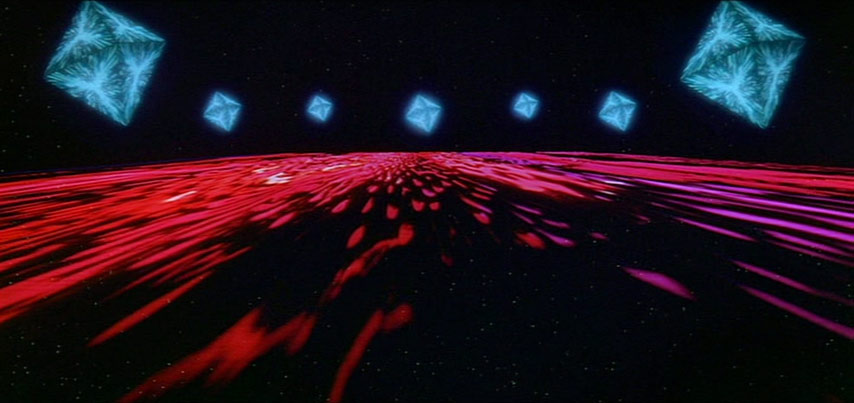
Once again we must look at the details of the shot for clues. One interesting detail is that the triangular surfaces of these geometric shapes are sucking light inwards. Unlike the stargate this light is not multi-coloured. Another, almost universally overlooked detail, is that at the very beginning of the shot a bright white object floats past in the lower right of the screen. It appears to be a lower case letter “i”.
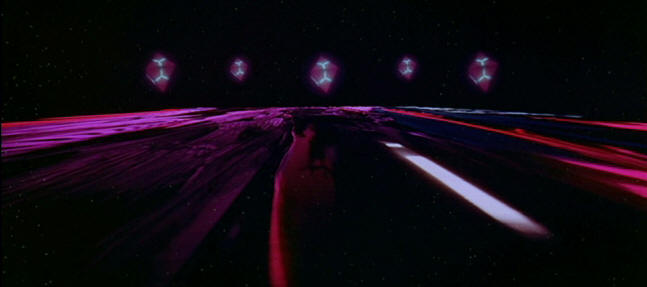
Confused? Well for more clues note that the shot cuts to a close up of a human eye and then cuts to a flat and unconvincing Earth-type landscape. The blue sky section of the landscape features uninteresting patterns of grey and white clouds, but look carefully at the end of the shot. The white lower case letter “i” rolls by again. This time it is in the top half of the screen – a direct mirror image – and in its upside down position it appears as an exclamation mark !!!
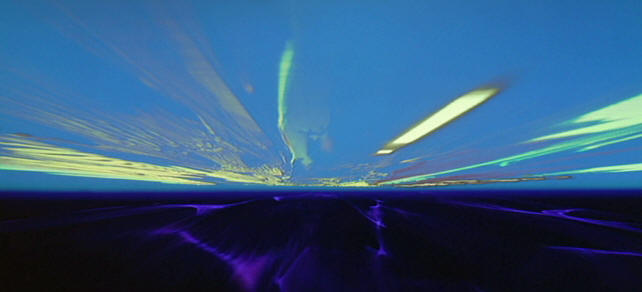
During my research for this review I stumbled across a website where someone had created a piece of software that could unravel the slitscan light patterns of the stargate. Here are the flattened out portions of stargate patterns as shown on the original site.


Luckily the researcher had applied the same process to the lower sections of the octahedron shot and the blue sky section of the landscape. Here are the results.


Notice that the illuminated letter “i” is a very prominent and deliberate feature. It is also apparent from the overlapping letter “i” sections, that the two shots are basically colour altered versions of the same slitscan pattern. This reinforces the notion of horizontal mirroring. The stargate also features at least one repetition point in its coloured light patterns.


Another possible re-inforcement of the illuminated letter “i” can be seen in the docking bay of the Torus station.

So putting these clues together, how else can we interpret the octahedron shot? Well first of all the bright white letter “i” is probably another illuminated “eye” symbol. It’s presence in the sky section of the landscape may also represent the rising sun or emerging starchild. As for the octahedrons, a brief bit of reading on geometry reveals that this shape is actually created by two mirror image pyramids joined at the base. So the concept of horizontal mirroring reveals that these shapes are actually the capstones of esoteric pyramid symbolism. The fact that they are sucking light in is most likely Kubrick’s statement that secretive religious orders do not bring enlightenment as they claim to. They actually suck enlightenment away and leave the Earth in spiritual darkness. Their absence in the second shot allows the sky to be truly illuminated by the sun. So what we are probably seeing here is two depictions of the same landscape – one in darkness and one enlightened.


Likewise the two shots of the sun emerging from a pyramid base with a crescent eye at the apex are most likely depicting night and day in the same landscape shot.


As for the visual arrangement of the seven octahedrons we need look no further than the lunar excavation scene. The six astronauts stand in a very similar arrangement before they walk down the ramp.

They then repeat this arrangement for the photo shoot with five of them in shot and one holding the camera. At this point they are seen flanked by huge flood lights on either side, which accounts for the two closer (or larger) octahedrons that float in off screen.


As it turns out the revelation of a mirrored reality is a curse for Floyd and his buddies, but for Bowman it is a new lease of life.




One last observation supporting these ideas is the visual comparisons between the Leopard from the Dawn of Man sequence and the photographer in the coucil meeting. The photographer's suit and shirt and tie feature a leopard hide like pattern. As he takes photos of Floyd we see that cuff links on both his arms give off bright reflections that parallel the leopard's shining eyes.



Being that this photographer is likely about to expose Floyd and his colleagues in their mischievious dealings, his stance as he leans toward the three men can be interpreted as that of a leopard about to pounce upon it's prey. Like a predator preparing for the kill, he has been eyeing up his enemy from several angles around the room.


Regarding the ape that is attacked by a leopard, this ape is a member of the clan that invade and steal territory and drinking water from a rival clan. this is not the group of apes who discover the monolith's meaning. For evidence to this effect, the clan that are driven away from the pool of water are seen wandering this same location before taking back their territory. The ape who discovers how to use a bone as a killing weapon is referred to in the book as Moonwatcher (another moon landing reference perhaps) and in the book he also kills the leopard. Though we don't see this happen in the film, it is hinted at because the ape begins smashing up a skeleton with a bone in the same location where the previous ape was attacked by the leopard.

Just like with Dr Strangelove, A Clockwork Orange, The Shining and Eyes Wide Shut, the hidden narratives of 2001 reveal Kubrick’s distain and distrust for secrecy associated with authority. Whether you believe in conspiracy theories or not, they were a central pillar of Stanley’s artistic output and were undoubtedly the main reason for his public silence on the meaning of his films.
Additional note:
It took a while to uncover this one, but thanks to the keen observations of an email correspondent, here it is. At many points in 2001 Kubrick gives us hints that we should be viewing his cinematic creation as a flat universe. The best example I can offer is this view of Bowman reaching out to touch the monolith. Being that the monolith is the cinema screen, it is neither far nor distant. Bowman's hand can touch it because it is just inches from him.
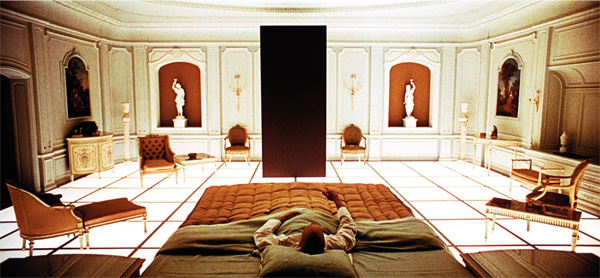
Another example of this flattened out screen paradigm is the monolith's low angle appearance as a pyramid.

And continuing with the flattened universe concept, let's look at the council meeting again. When Floyd says: "This is the view of the council", the camera angle changes so that we see the rooms tables in a pyramid formation with Floyd at the apex.

Remember that the end of the stargate began to whiten out and reveal a blank cinema screen, thus making a visual connection to the blank screen behind floyd. Being that the stargate then cut away to a shot of an eye and then the explosion of consciousness, what happens if we project those images on the screen behind Floyd?
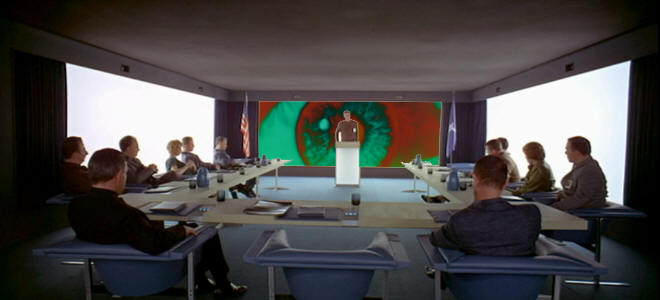

What we now see is Kubrick's uncompromising message that Dr Floyd does indeed represent the illuminated eye, as seen in freemasonic art, with the council table the pyramid base.

The shot which preceeded the council meeting further supports this. The moonbase is presented as a sublimnal connection to the dazzling stargate explosion.

Our "view of the council" as Floyd puts it, was Kubrick's attempt to expose a secretive organisation which he clearly was convinced play a key role in world events. His follow up film to 2001, A Clockwork Orange, also featured the masonic eye in a triangle on it's marketing poster.
